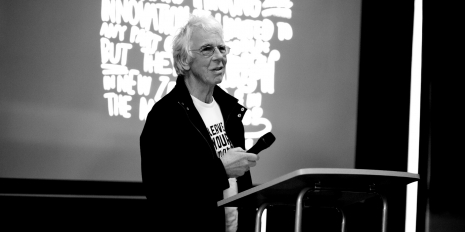
About 80 keen local business people from around the Bay of Plenty braved an early morning start on Friday 27 July to hear Mark Pennington talk about the importance of design and innovation in business. Mark is one of New Zealand’s most highly awarded and commercially successful designers and design educators.
Mark was in the Bay to speak at this year’s Young Innovator Awards and we thought it was also a great opportunity to host a breakfast for local business.
Mark’s enthusiasm is infectious and his openness refreshing. He tells a great story. I can tell you from personal experience he’s great to work with. A perfectionist, but not weighed down by his ego; a fun loving guy, but not afraid to tell it like it is; and perhaps most importantly in today’s workplace a real team player and supporter.
Mark led off his presentation with the quote “Forward thinking and innovation are not limited to any part of the world: but they flourish in New Zealand and in the minds of Kiwis” from Time Magazine. This set up the first part of the presentation which explored what it is about us Kiwi’s that helps us to be innovative and achieve great things. He talked about our forefathers and our pioneering heritage. The heros of the past that still inspire us today; Kate Sheppard (Suffrage), Burt Munro (Worlds Fastest), Ernest Rutherford (The Atom), and Richard Pearse (Flight). Today we still have this pioneering spirit which enables us to be fresh, unencumbered thinkers and do extraordinary things, literally from our own back yard. Bill Hamilton, who invented the Hamilton jet in response to his need to traverse the shallow and rocky Rakaia river through his farm.
Mark likened NZ to a teenager – youthful, energetic, adventurous, free spirited and can-do. He said we should embrace this heritage and spirit in our design endeavors. We must be user focused and design products and services with integrity. To do this we need to dive deep and really try and understand the problem fully in order to gain valuable insights. Striving for this conceptual clarity and attacking the project with the kiwi can-do attitude is where you’ll find the magic.
The second part of the presentation was about Formway Design. Mark talked about Formway’s products which all started with the deep dive. The conceptual clarity which was gained at the front end of the projects drove the design and the marketing and enabled products which work exceptionally well and stand the test of time because they are so “right”. Mark also mentioned work done for Air NZ seating and a Methven shower which were undertaken with the same approach and delivered great outcomes.
Mark spent some time explaining the positive impact winning international design awards had on the company and their self belief and camaraderie, as well as the marketing benefits. He then went on to talk about Formway Design’s partnership with Knoll. Knoll licensed the Life chair in 2002 and now total revenue exceeds $700m. Life has become the highest selling product in Knolls history and was a global environmental benchmark. Despite the difficult economic environment, in 2009 Knoll launched the Generation chair (called the Be Chair in Australasia). It was the fastest product ramp up in Knolls history and so far over 50,000 chairs have been sold. The impact that Formway Design’s products have had on Knoll’s bottom line are impressive – growing their seating revenue from $21M to $72M in 2009.
The essence of Formway’s business model is:
The final part of the presentation gave an overview how Formway Design does such great work. Their design process is split into 3 major stages – discover, design, deliver.
The first stage, discover, is about diving deep; understanding the market, understanding the user through techniques such as observational research and voice of the customer and uncovering unmet needs. At the end of this stage they pull together this understanding and insight into a philosophy to drive their design. He also highlighted the benefit of consulting with experts – don’t be afraid to ask for help from the best people in the world.
The second stage, design, is about finding solutions. Doing what ever it takes to find the answer. Building lots of prototypes and trying them out. Pushing materials to their limits. Most importantly always keeping the user top of mind.
The final stage, deliver, is about getting to market with the right solution. Designers need to stay involved right through tooling, manufacturing ramp-up and marketing to ensure the integrity and authenticity of the design remains intact. The early discovery work leads directly into the marketing – the story is already there and inherent in the product, not a tack on at the end.
Thanks Mark for inspiring us all on a Friday morning! Thanks also to Angela at ExportNZ for organising this event with the support of us here at Locus Research, Woods Creative and Enterprise Angels.
Comments
Post new comment